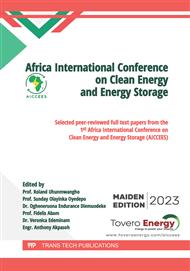[1]
Profile of South-Eastern Nigeria and Description of the Study Area Profile of south-eastern Nigeria. (2001).
Google Scholar
[2]
Ohadike, D. C. Igbo Culture and History.pdf. Preprint at (1960).
Google Scholar
[3]
Chinwuba, P. Determinants of Participation in Nonfarm Economic Activities in South East Nigeria : A Tobit Analysis Approach. 5, 102–109 (2015).
Google Scholar
[4]
World Bank. Nigeria Socio Economic Assessment 1. World Bank 3–17 (2011).
Google Scholar
[5]
Umezinwa, C. Health and economic growth in South East, Nigeria. African Research Review 10, 111 (2016).
Google Scholar
[6]
Odoh, N. E. & Nwibo, S. U. Socio-Economic Determinants of Rural Non-Farm Households Income Diversification in Southeast Nigeria. International Research Journal of Finance and Economics-Issue 164, 116–128 (2017).
DOI: 10.4314/jae.v23i2.12
Google Scholar
[7]
Amaechi, C. M. & Muoh, O. U. Women and development in Africa: Urbanization and the role of Umuada in Igboland, Southeast Nigeria. Asian Women 34, 85–107 (2018).
DOI: 10.14431/aw.2018.03.34.1.85
Google Scholar
[8]
Obi-Ani, N. A. & Isiani, M. C. Urbanization in Nigeria: The Onitsha experience. Cities 104, 102744 (2020).
DOI: 10.1016/j.cities.2020.102744
Google Scholar
[9]
Jelilov, G. & Iheoma, H. The Impact Of Industrialization On Economic Growth: The Nigeria Experience (2000-2013) Entrepreneurial Trade Fair (Turkmenistan) 2012 View project Entrepreneurial Trade Fair (Turkmenistan) 2010 View project THE NIGERIA EXPERIENCE (2000-2013). British Journal of Advance Academic Research 5, 11–20 (2016).
Google Scholar
[10]
Unizik journal of business. 1, 81–92 (2018).
Google Scholar
[11]
Idika, U. Factors that Hinder Effective Domestic Energy Management Practices within Households of Urban and Rural Areas of Abia State. 5, 1–16 (2018).
Google Scholar
[12]
Diji, D. A Critical Review of the Nigerian Energy Scenario. IOSR Journal of Electrical and Electronics Engineering 5, 55–67 (2013).
DOI: 10.9790/1676-535567
Google Scholar
[13]
Onwumere, J. C., Amaghionyeodiwe, C. A. & Ndukwe, E. C. Effect of epileptic power supply on the investment and performance of bakeries in Abia State, Nigeria. Nigeria Agricultural Journal 50, 92–99 (2019).
Google Scholar
[14]
REA. Nigeria Electrification Project (NEP). (2023).
Google Scholar
[15]
Okedu, K. E., Sarah, K., Kayoade, I. & Roland, U. Impact of the Independent Power Producers and National Integrated Power. 20, 147–170 (2018).
Google Scholar
[16]
Facts, B. Engineering The Profile of Energy Generation and Consumption in Nigeria Department of Pure and Industrial Chemistry , Nnamdi Azikiwe Department of Chemical Engineering , Nnamdi Azikiwe University ,. 194–201 (2016).
DOI: 10.30880/ijie.2021.13.04.019
Google Scholar
[17]
Elizondo, E. et al. Productive Use of Energy – PRODUSE Measuring Impacts of Electrification on Small and Micro-Enterprises.
Google Scholar
[18]
Ukoima, K. & Agwu, E. O. Review of the Impact of Electricity Supply on Economic Growth : A Nigerian Case Study Review of the Impact of Electricity Supply on Economic Growth : A Nigerian Case Study. IOSR Journal of Electrical and Electronics Engineering 14, 28–34 (2019).
Google Scholar
[19]
Amuji, H. O., Nwachi, C. C., Nicholas, N., Mbachu, J. C. & Owolabi, W. T. Correlation Analysis of Enugu Electricity Distribution Company ' s Electricity Bill. 10–19 (2023).
Google Scholar
[20]
Clinton, D. & Chinago, A. B. State of power supply in Nigeria, the way out. International Journal of Development and Sustainability 7, 435–447 (2018).
Google Scholar
[21]
Igbinovia, F. An overview of Renewable energy potential in Nigeria: Prospects, Challenge and the Way forward. Energetika Journal 46, 570–579 (2014).
Google Scholar
[22]
Njoku, M. C. et al. GLOBAL SOLAR RADIATION UTILIZATION IN SOUTH-EAST OF NIGERIA. 1141–1152 (2022).
Google Scholar
[23]
Ramanjaneyulu, G. & Reddy, B. R. Emerging trends of microorganism in the production of alternative energy. Recent Developments in Applied Microbiology and Biochemistry 275–305 (2018).
DOI: 10.1016/B978-0-12-816328-3.00021-0
Google Scholar
[24]
Ukoba, M. O. et al. Geographic information systems (GIS) approach for assessing the biomass energy potential and identification of appropriate biomass conversion technologies in Nigeria. Biomass Bioenergy 170, 106726 (2023).
DOI: 10.1016/j.biombioe.2023.106726
Google Scholar
[25]
Joardder, M. U. H., Halder, P. K., Rahim, M. A. & Masud, M. H. Solar pyrolysis: Converting waste into asset using solar energy. Clean Energy for Sustainable Development: Comparisons and Contrasts of New Approaches 213–235 (2017).
DOI: 10.1016/B978-0-12-805423-9.00008-9
Google Scholar
[26]
Somorin, T. O., Adesola, S. & Kolawole, A. State-level assessment of the waste-to-energy potential (via incineration) of municipal solid wastes in Nigeria. J Clean Prod 164, 804–815 (2017).
DOI: 10.1016/j.jclepro.2017.06.228
Google Scholar
[27]
Chima, I. K. & Nwabinye, V. Economic Analysis of Household Waste Generation, Disposal and Management in Umuahia Metropolis, Abia State, Nigeria. International Journal of Health Economics and Policy 2, 47 (2017).
Google Scholar
[28]
Ohunakin, O. S., Ojolo, S. J. & Ajayi, O. O. Small hydropower (SHP) development in Nigeria: An assessment. Renewable and Sustainable Energy Reviews 15, 2006–2013 (2011).
DOI: 10.1016/j.rser.2011.01.003
Google Scholar
[29]
Odiji, C. et al. Small hydropower dam site suitability modelling in upper Benue river watershed, Nigeria. Appl Water Sci 11, (2021).
DOI: 10.1007/s13201-021-01466-6
Google Scholar
[30]
Oyinna, B. et al. Assessing small hydropower sites in Nigeria for sustainable development using ArcGIS. Energy Reports 10, 2889–2898 (2023).
DOI: 10.1016/j.egyr.2023.09.102
Google Scholar
[31]
CHİEMELU, N.E., NKWUNONWO, U., OKEKE, F.İ. & OJİNNAKA, O.C. Geospatial Evaluation of Wind Energy Potential in the South-East and South-South Sections of Nigeria. International Journal of Environment and Geoinformatics 6, 244–253 (2019).
DOI: 10.30897/ijegeo.549796
Google Scholar
[32]
Nkemdirim, V.U., Alozie, G. C. & Felix, I. Spatial Analysis of the Quality of Groundwater Supply: Evidence from Abia State. American Journal of Water Resources 4, 83–90 (2016).
Google Scholar
[33]
UNIDO. Incentive Policies for Small Hydropower Development. 1–8 (2019).
Google Scholar
[34]
Ukoba, M. O. et al. Optimal sites for agricultural and forest residues energy conversion plant using geographic information system. Heliyon 9, e19660 (2023).
DOI: 10.1016/j.heliyon.2023.e19660
Google Scholar
[35]
Asadi, M., Pourhossein, K. & Mohammadi-Ivatloo, B. GIS-assisted modeling of wind farm site selection based on support vector regression. J Clean Prod 390, (2023).
DOI: 10.1016/j.jclepro.2023.135993
Google Scholar
[36]
ESRI Geographical Information System, 2020.
Google Scholar


